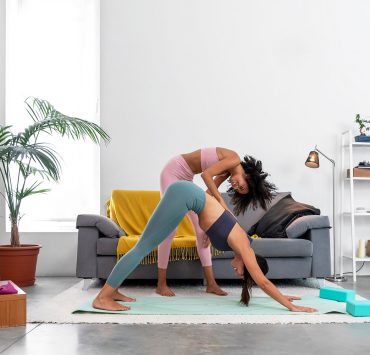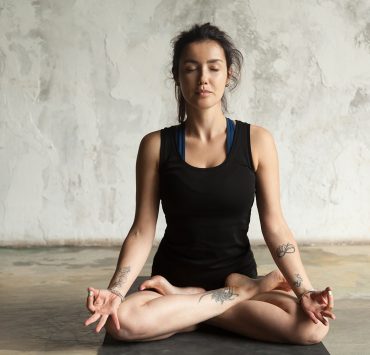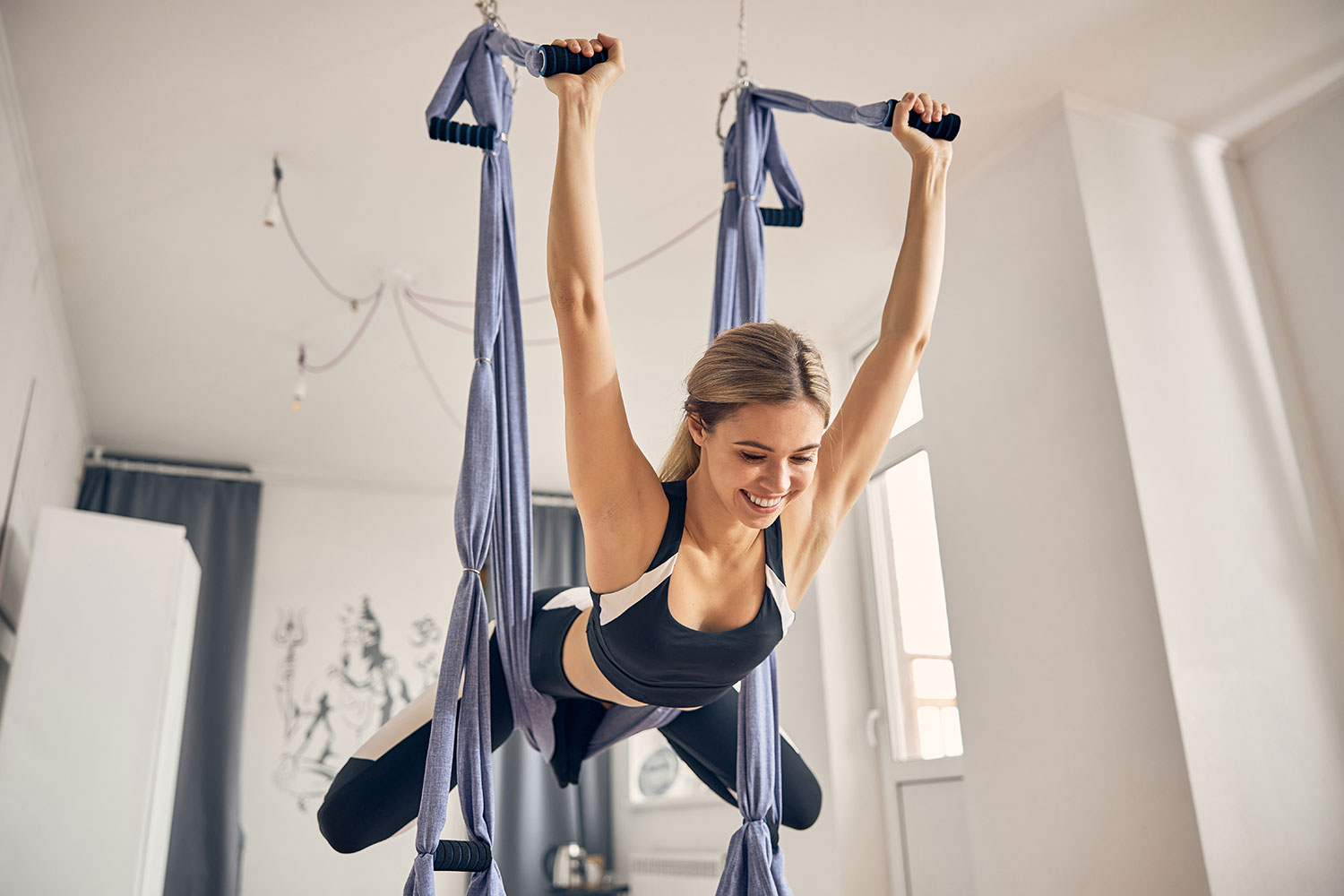
Susan views the world through a lens of spirituality, health,…
The Yoga Swing is a fun way to practice asana while suspended in the air. It is a combination of yoga and trapeze acrobatics that makes you feel like you’re flying gracefully.
It allows you to practice various asanas with the support of a strong fabric hammock. And it’s quite useful for staying in inversions to decompress your spine and doing other aerial yoga tricks.
It was developed in the early 2000’s and today there are many variations of it on the market. Although it is a relatively new trend in modern postural yoga, the idea behind it is based in history.
This guide will tell you all you need to know about how the yoga swing and aerial yoga came to be. If you have your own yoga swing or hammock, you can also practice some simple, beginner-friendly yoga swing poses.
Yoga Swing History
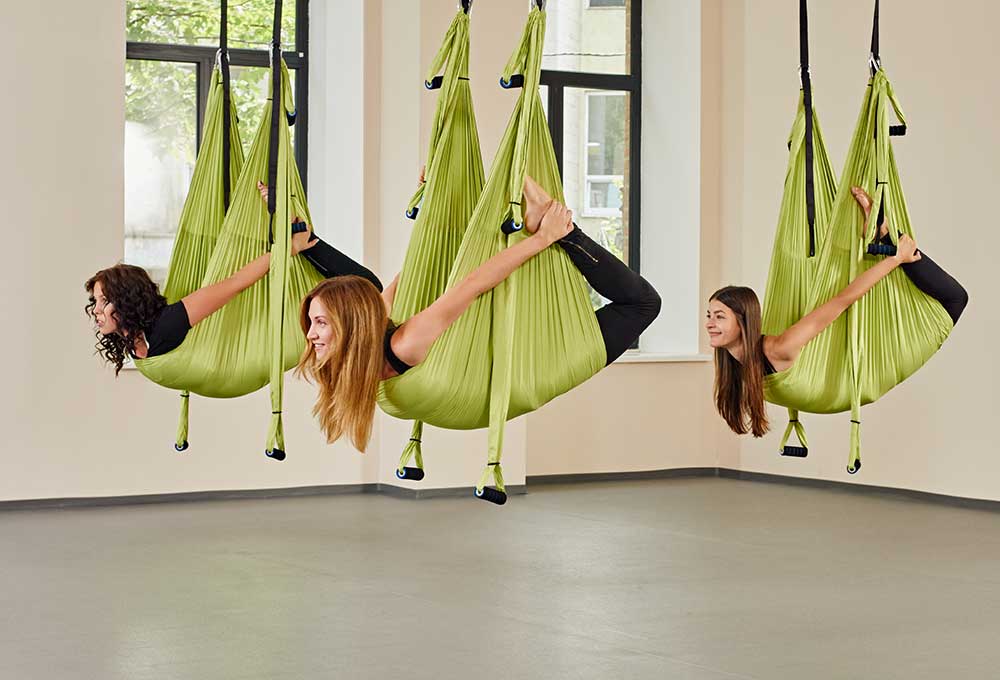
Photos dating back to 3000 B.C.E show how devices made of rope were used to help yoga practitioners into inverted yoga poses. This was used as a tool for support for certain asana rather than a whole yoga practice in a swing.
B.K.S. Iyengar, who became known for developing a style of modern yoga that uses props, also used ropes and harnesses as tools to assist and go deeper into various levels of asanas.
Iyengar did not have sophisticated yoga swings yet so these slings were made of improvised ropes, yoga straps, blankets, and other materials.
The first modern yoga swing may be traced back to the United States. Antonio ‘Tone’ Cardenas was a physical therapist for 20 years who developed his vision for a yoga swing in 2001 to help himself heal his own back injuries.
Around the same time period, in 2003, the “Gravotonics Yoga Swing & Exercise System” was developed in Bali, Indonesia. The trend began to pick up and in 2004, Lucas Rockwood discovered the yoga swing in Thailand and went on to design his own version called the Yoga Trapeze.
How to Practice Yoga in a Swing
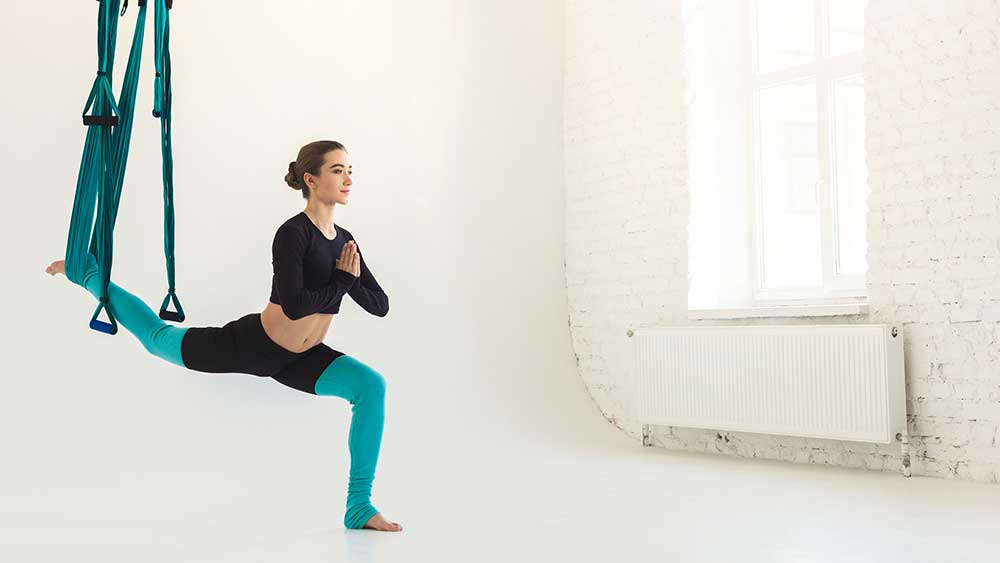
Yoga swings can be used for Aerial Yoga. There are many styles that fall under this umbrella term. Some may even use a specific brand of yoga swing, hammock, or trapeze.
Aerial yoga is a practice that combines yoga asanas, gymnastics, pilates, and circus acrobatics. It can be a dynamic, full-body and mind workout or a restorative practice. The yoga swing can be used as a tool to support a pose, or the whole practice can be done while hanging in the swing.
One of the most popular styles of Aerial Yoga is AntiGravity Yoga which was created by Christopher Harrison. He first created AntiGravity Fitness in 1991. A few years later, he traveled to India and added hatha yoga asanas to his classes.
Some of the yoga asanas that can be practiced in a yoga swing look familiar. They may even share the same Sanskrit names as traditional yoga poses. But the practice is very different from yoga practiced on a mat. And the benefits of the practice on your spine is mainly what brings people back to it.
Where to Find Yoga Swings
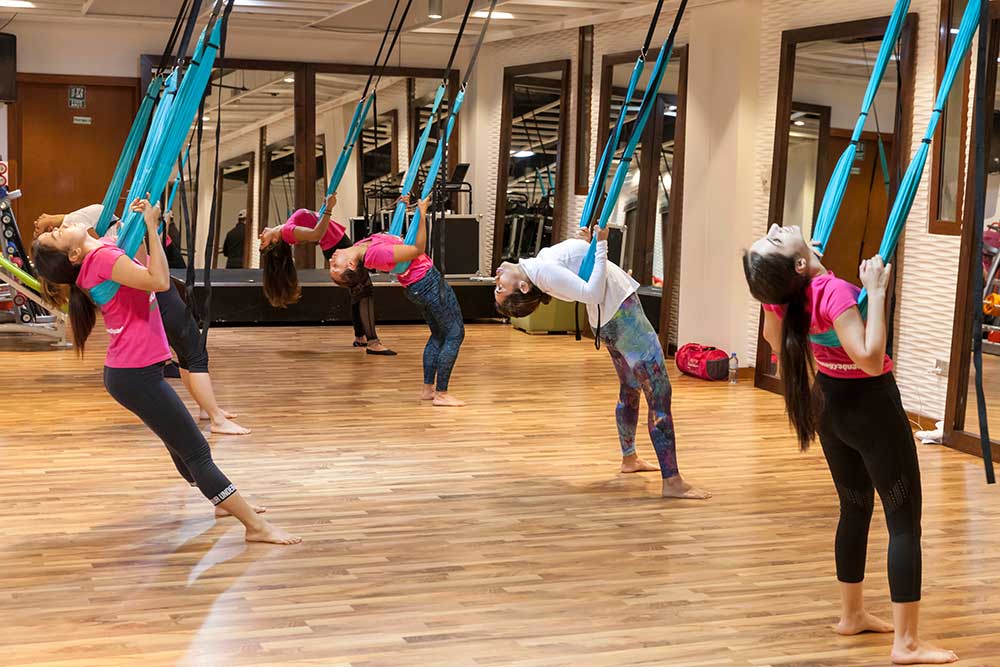
There are many yoga swing brands to choose from. Some have handles that are used to support certain poses differently. Others have multiple layers of fabric to hold up different areas of your body.
These are some of the most popular yoga swing brands available today:
Yoga Trapeze by Gravotronics
This yoga swing claims to be one of the originals in Aerial yoga. The company has been around since 2003. Each swing is handmade in Bali and has a 440 lbs. load capacity.
This yoga swing is made of parachute fabric and has three padded handles on each side.
In addition to emphasizing safety in construction, the company also gives back 5% of their profits to local community groups in Bali that are dedicated to cleaning up the environment.
Omni Yoga Swing
The Omni Yoga Swing comes in various price points. You can get the basic yoga swing all the way up to the swing with all the bells and whistles, including a freestanding frame.
The company makes all their yoga swings in Chico, California, USA. They offer customizations to your yoga swing such as extra padding for your seat, a portable stand, extra chains, and others.
They also offer assistance to get your yoga swing purchase funded by your health insurance provider.
Yoga Trapeze Swing by YOGABODY
This swing is used in YOGABODY franchise yoga studios around the world. It consistently comes up as one of the best yoga swings on the internet.
They are so confident in the quality of their yoga swings that they offer a 10-year warranty on parts or the whole swing.
Yoga Swing Safety Tips
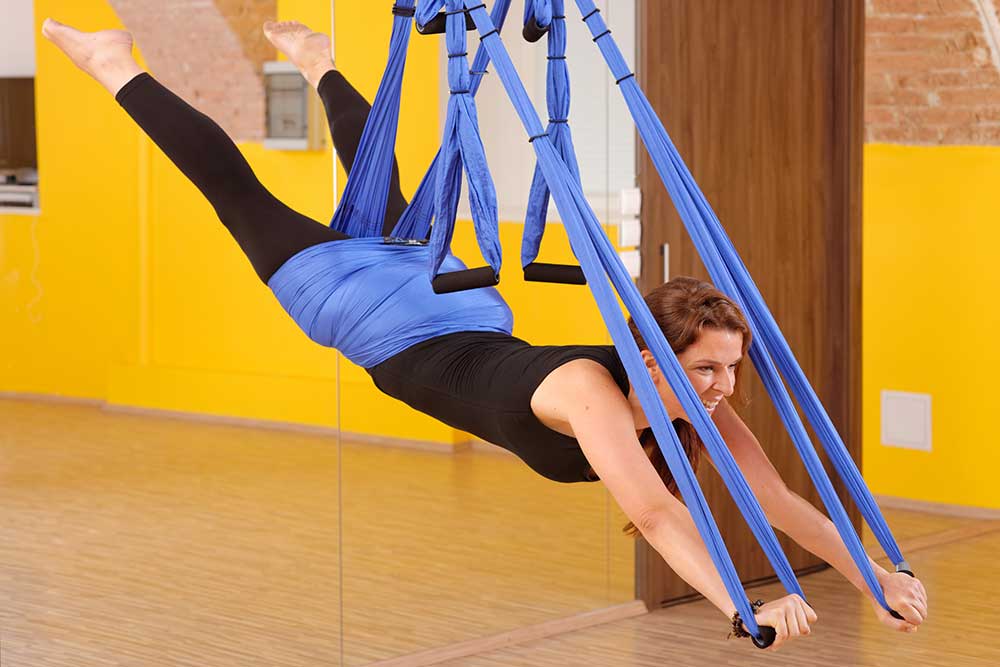
No matter which yoga swing you purchase, there are some general safety tips you can follow.
- Start at the beginning.
Even if you already have a regular yoga practice, asana on the floor is completely different from asana in the air. Join a class with a certified yoga instructor who specializes in aerial yoga and master the basics before you try the fancier tricks in the hammock. - Do not practice on a full stomach.As with any yoga practice, or physical practice for that matter, do not get in a yoga swing if you just ate. Wait at least 3 hours for your food to digest before doing any rigorous physical activity such as going upside down on a yoga swing.
- Check the yoga swing’s load capacity.Even if you go to an aerial yoga class, it’s good to check this information with your teacher or manager of the yoga studio. In addition to checking the load strength, also look if all the chains are in good shape and if the fabric is in good condition.
- Wear appropriate clothing.Avoid yoga clothes that are too loose because they may get tangled up in the yoga swing fabric. But also cover up your skin because exposed areas that come into contact with the fabric a lot may get irritated or get friction burns. Also don’t wear clothes that have zippers, buttons, or other embellishments that might damage the fabric.
- Consult your physiotherapist or general medical practitioner before going to a yoga swing class.This is especially true if you recently had surgery or botox, or if you know you have a pre-existing condition like herniated discs, sciatica, spondylolisthesis, vertigo, or hypermobility. Also, consult a doctor if you are pregnant before starting any new movement or fitness activity.
12 Yoga Swing Poses
Whether you’ve purchased a new yoga swing or signed up for aerial yoga classes, have fun with your new yoga prop. Be mindful in your new practice by finding that perfect balance between pushing your limits but also respecting your boundaries.
Here are 12 basic yoga swing poses you can try while you get the hang of it.
Standing and/or Supported Aerial Yoga Poses
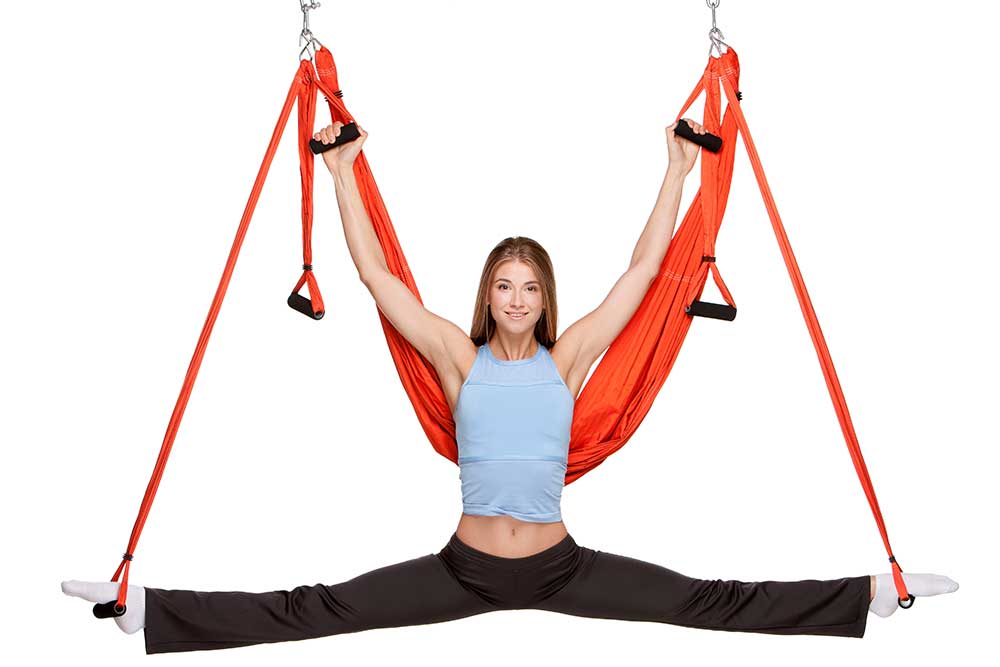
These first 6 poses are practiced with parts of your body still rooted on the ground. The yoga swing is used as a prop to support parts of your body rather than holding your entire weight off the floor.
- Shoulder Stretch in Wrist Wrap
This pose is similar to Ardha Uttanasana=, or Half Forward Fold. But instead of placing your hands on the ground or on your legs, you will hold onto the fabric of the yoga swing. This will expand your chest and stretch your shoulders and spine. - Hanging Plank
In this version of the plank, you keep your hands firmly planted on the ground. Place both your feet in the yoga hammock. Make sure the fabric is low enough so that your body is horizontal to the ground. Since your glutes don’t have to engage when your feet are supported in this plank, it can help relieve lower back pain.At the same time, just like a normal plank, this asana strengthens and tones your core, shoulders, arms, and spine.
- Pike and Pull with the Foot in the Hammock
This unconventional yoga pose was dubbed the “Finding Your True North Pose” by Wanderlust. You will resemble an archer in this yoga swing asana. But the yoga swing will be your bow and your own leg and foot will be your arrow.This pose is a spinal twist which also helps with balance. You will also get a good stretch in your legs, thighs, and hips. - Hanging Chair
Utkatasana, or Chair Pose, was used by Vedic gurus of India as a punishment for students. But this hanging version of Chair in a yoga swing removes the difficulty of the pose. Instead, your spine will be free to lengthen as gravity does most of the work for you.This pose decompresses your spine and relieves sciatica and lower back pain. - Supported Downward Facing Dog
You can practice Adho Mukha Svanasana, or Downward Facing Dog, with a yoga swing supporting your hips. This will ease the pressure on your wrists and decompress your spine. You may also find it easier to bring your heels in the direction of the ground when your body is supported in the swing.
- Extended Cobra
Bhujangasana, or Cobra Pose, with the help of a yoga swing, can help deepen the pose but be careful not to go too far too quickly. Practice this pose with your belly on your mat but instead of holding your torso up with your arms, hold onto the fabric of a yoga swing. This makes the stretch come frog hanging down from the yoga swing rather than pushing into the earth.
Inversions and Aerial Yoga

A yoga swing can take a lot of the fear out of practicing inversions in yoga. The feeling of being off the ground can make you feel like you’re flying.
- Star Inversion
Most of your body weight will be held up by the yoga swing in this inversion, but you can still touch the ground which can help make you feel less anxious. Extend your limbs as far out as possible to form the five points of an upside-down star to get the maximum stretch.
- Flying Bridge
Support your spine while practicing Setu Bandhasana, or Bridge Pose. This backbend is completely off the ground while you suspend yourself securely in your yoga swing. It will allow you to completely surrender into the pose for a deeper stretch in your spine.
- Floating Boat
Navasana, or Boat Pose, is challenging already on the ground. Practicing this asana in a yoga swing adds another level to this pose but also helps be removing the pressure from your tailbone.
- Bat
Bat is an upside-down, hanging version of Baddha Konasana, also known as Bound Angle Pose or Butterfly. The yoga swing helps decompress your spine while opening up your hips.You may either let your arms hang down or try a variation with your palms facing each other in a prayer position behind your back.
- Floating Seated Twists
Seated Twists are fun and easy yoga poses to gain confidence in a yoga swing. Simply sit in the yoga hammock-like your would in a chair. You may either keep your feet on the ground or raise the swing high enough so that you are suspended completely in the air.
- Floating Savasana
As with any yoga class, end your yoga swing practice with the final resting pose called Savasana or Corpse Pose. Lay down inside your swing so that your entire body is supported by the fabric of the hammock. Close your eyes and relax completely into this final aerial yoga pose.
What's Your Reaction?
Susan views the world through a lens of spirituality, health, and compassion. Her positive outlook on life shines through her writing, which is heavily focused on yogic living, meditation, and conscious eating.






